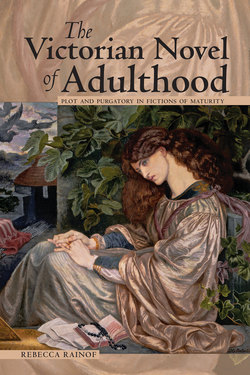Читать книгу The Victorian Novel of Adulthood - Rebecca Rainof - Страница 12
На сайте Литреса книга снята с продажи.
ОглавлениеCHAPTER TWO
George Eliot’s Winter Tales
If Henry James famously criticized Daniel Deronda for being more like a lake than like a river in terms of its narrative flow, Gwendolen Harleth’s widowhood can be considered the deepest and stillest part of Lake Deronda.1 She begins the novel as a willful young woman, a “spoiled child,” as the novel labels her, but concludes as a widow quietly returning to live with her mother and sisters at Offendene. Early readers found this ending frustrating enough that one American fan anonymously penned a sequel called Gwendolen, published in 1878, two years after the original, which culminates in the heroine’s marriage to Daniel (Mirah having been conveniently dispatched).2 Evidently, though Gwendolen in Eliot’s novel at first worried that marriage would be painfully “humdrum,”3 readers have had a bigger problem with the “humdrum” once it is divorced from the marriage plot and made a conclusion on its own, a divorce that Eliot insists upon for her heroine at the end of Daniel Deronda.
Although Eliot grants the marriage plot to her hero and Mirah instead, she does not leave her heroine bereft, as many have claimed.4 Instead, she refocuses Gwendolen’s storyline on a gradualist vision of change that many have been tempted to overwrite as punitive stasis. Echoing early reader malaise, critics have called Gwendolen’s widowed end “tragic,” seeing her as “fixed in her tableau of tragic dread.”5 On the contrary, the narrator insists that Gwendolen is not “fixed” in her concluding state but may be “supposed to move, like the limpet, by an apparent sticking, which after a good while is discerned to be a slight progression” (DD, 701). We learn that Gwendolen’s current and future transformation will be enacted on the scale of the “quiet recurrence of the familiar” instead of “the revolutionary rush of change which makes a new inner and outer life” (DD, 701). The tendency to reject this gradualism as stasis can be identified as part of a larger scholarly trend that flirts with branding Eliot a “conservative,” thereby refusing to accept Eliot’s vision of gradual progress as true progress at all.6 As a counter-reading to such scholarship, this chapter explores Eliot’s insistent fascination with extreme gradualism and how it is linked to her most unconventional approaches to plotting stories for her mature protagonists. In these works, which include Scenes of Clerical Life, Silas Marner, Middlemarch, Romola, and Daniel Deronda, Eliot resists the pull of the marriage plot to give failed first endeavors less attention in a larger story of second chances.7 This period of adulthood attained becomes the subject of Eliot’s most radical writing, for in depicting maturity at length and, in some cases, as a “humdrum” conclusion protested by readers, Eliot launches an embedded critique of the marriage plot and the bildungsroman as the main plots available in Victorian fiction.
I. Adventures for “Grown-Up People”
This approach to plotting the “humdrum” would seem to be completely at odds with the vim of the adventure story. Adventures are for young people, at least if one believes Georg Simmel, whose definition has shaped numerous studies of the bildungsroman and its tumultuous plots. As Simmel writes,
The adventure does not belong to the life-style of old age. The decisive point about this fact is that the adventure, in its specific nature and charm, is a form of experiencing. . . . The old person usually lives either in a wholly centralized fashion, peripheral interests having fallen off and being unconnected with his essential life and its inner necessity; or his center atrophies, and existence runs its course only in isolated petty details, accenting mere externals and accidentals. Neither case makes possible the relation between the outer fate and the inner springs of life in which the adventure consists; clearly, neither permits the perception of contrast characteristic of adventure, viz., that an action is completely torn out of the inclusive context of life and that simultaneously the whole strength and intensity of life stream into it.”8
